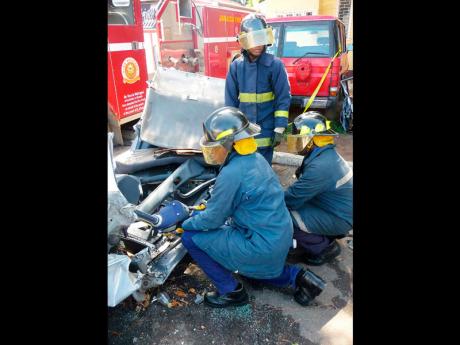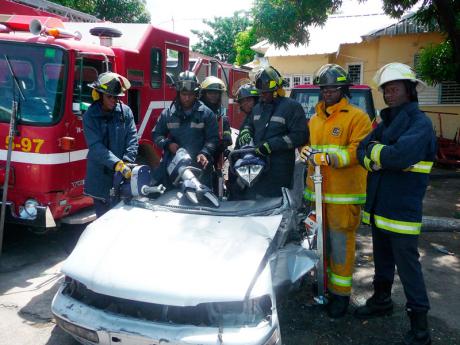The ABC of rescue - Electrical company donates portable Jaws of Life
Sheldon Williams, Gleaner Writer
The Kingston and St Andrew Division (Area 1) of The Jamaica Fire Brigade recently had its lifesaving capabilities boosted with the donation of a Hurst hydraulics rescue tools system - more popularly known as Jaws of Life. It is used to extricate persons who are trapped in vehicles after crashes.
The system consists of a spreader, cutter, ram, pedal cutter and rescue struts - each component serving a critical purpose in the extrication process
Powered by hydraulic presure, it is the only portable one in the island. ABC Electrical Sales handed over the equipment at the York Park Fire Station on August 22.
Noel Chang, manager of ABC Electrical Sales, told
Automotives that he was moved to donate the equipment
following a January 2013 incident on Port Henderson Road in Portmore,
St Catherine. Alraine Witter was mistakenly declared dead by a man
claiming to be a doctor and was left trapped in his mangled car for an
hour following a collision.
"I have teens on the road
and am concerned about situations like that," he said. "I know Deputy
Commissioner Rudyard Spencer well and I called him up and asked if I
could donate something like this," Chang added.
"I got
it through my very good supplier in Miami. We made arrangements with
them and we will be paying for it over a period of
time."
Jamaica Fire Brigade District Officer Warren
Thompson explained that "the ram is used to normally push, mostly for
pushing, while the spreader is used mainly to pull, spread and squeeze,
and the cutter is used to cut through metal. The pedal cutter is used to
cut pedals, because the material used to make pedals is usually
stronger than the material used to make the vehicle. The rescue strut is
used to stabilise a vehicle".
Sergeant Rowan Williams
reiterated that this is the first time hydraulic-powered Jaws of Life
will be used in the island, but reassured that firefighters are being
sensitised about how to use it. However, Williams said, the procedure is
similar to the equipment requiring a hose connection which is currently
available, known as Holmatro rescue
equipment.
"Hydraulic fluid is actually inside all the
equipment. It is compressed when you are using it, so it pushes it out.
The previous one had to use a pump," Williams
explained.
DO Thompson said the Hurst Jaws of Life is
much heavier than the Holmatro version, so firefighters continue to
receive training to make the transition smoother. The Hurst system will
not be a replacement, but an addition to the brigade's rescue
capabilities. "By the end of the month, the entire Kingston and St
Andrew division will be exposed," Thompson said.
A
representative from the manufacturer conducted a four-day tutorial with
staff following the donation. "He did a class orientation about the
equipment and he did a practical aspect about working with it," Williams
pointed out.
At the same time, Thompson was quick to
highlight the advantages of the Hurst Jaws of Life. "It can be used in
some very remote areas and is less cumbersome because, unlike the one we
use now, we will not have to travel with generator and hose and stuff
like that. It can be used in search and rescue and can actually be
rappelled from a building," he said.
The equipment
uses a lithium ion powered battery. "In an operation, it lasts up to 30
minutes and, when fully charged, it lasts two weeks without an
operation. Each piece of equipment comes with two batteries," Williams
said. LED lights are also affixed to the equipment to provide visibility
during night operations or rescue efforts in badly lit
areas.
DO Thompson said modern vehicles are equipped
with safety mechanisms which might pose a challenge to using the Jaws of
Life, Therefore hazard assessment is very important. "Motor vehicle
manufacturers put in some safety devices that make it hard for us when
we are to make a cut in a vehicle. We have to look for sensors, "
Thompson said.
"When we go on an operation, we just
don't go and cut. First of all, we establish a parameter and do hazard
mitigation - and that depends on the vehicle. A car might fall on an
energised utility pole, so we can't just go in. So when people say 'we
reach and just stand up and nah do nothing', that's not true. Assessment
first," Thompson said.
"Some vehicles come with
airbags in seat belts and rollover sensors and airbags in steering
wheels," Williams pointed out. So if firefighters are unaware where
safety sensors are in vehicles, they can do more harm than good in
trying to extricate the trapped person. "Can you imagine if we miss a
sensor and you are not dead and an airbag explodes in your face? That's
nitrogen," Thompson remarked.
That is why, he said,
"we try to keep abreast of all the new
technologies".
PHOTOS BY SHELDON WILLIAMS





